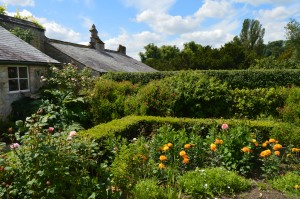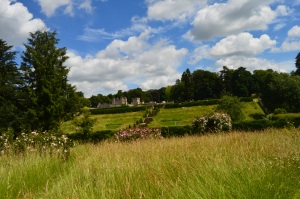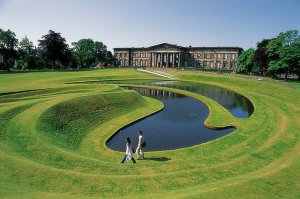Easton Walled Gardens, are the dream child of Ursula Cholmeley. The tudor house was demolished in 1951, leaving only the tudor walls of the park in need of repair, stables crumbling down, some terraces running down to the River Witham and a Yew walk way hundreds of years old. The proximity of the A1 must have made the 12 acre site a daunting prospect alone. The owners could have walked away, rented out the land for grazing and forgotten about this little corner.
Ursula Cholmeley has sensibly not let that disease of “gardeners ego” (from which we all suffer) to take over. She has avoided the mistake of trying to revive such a site and restore it in the grand tradition of the Lost Gardens of Heligan. Money and labour in the 21st century are all in short supply, and the arrogance of showing off ones wealth and power in the garden is frowned upon, unless done by committee in the name of The People, (pace, National Botanic Gardens of Wales)
Easton Walled Gardens are a revival and a reinterpretation of a landscape for the modern egalitarian era. Intimate spaces in The Pickery, vegetable areas and alpine beds make it accessible and easy to understand for all.  The identification with the British nation’s beloved sweet peas is a genius attempt at being both down to earth, and still claiming the grandeur of a “Sweet Pea Week”. It is this careful balance of trying to attract the paying public to a memorable garden without shouting about it that makes Easton Wall an art form in marketing a modern garden for modern times.
The identification with the British nation’s beloved sweet peas is a genius attempt at being both down to earth, and still claiming the grandeur of a “Sweet Pea Week”. It is this careful balance of trying to attract the paying public to a memorable garden without shouting about it that makes Easton Wall an art form in marketing a modern garden for modern times.  The intimate spaces are balanced against the wider meadows and terraces of the old formal gardens. There are snow drop weeks, photography competitions, and the ubiquitous tea rooms and tasteful shop. Helpful notes point out that snowdrops will only be seen in the early year, should visitors need guidance, but the tea rooms are always open. The politics of running a garden are legion when they have to pay for themselves.
The intimate spaces are balanced against the wider meadows and terraces of the old formal gardens. There are snow drop weeks, photography competitions, and the ubiquitous tea rooms and tasteful shop. Helpful notes point out that snowdrops will only be seen in the early year, should visitors need guidance, but the tea rooms are always open. The politics of running a garden are legion when they have to pay for themselves.
Instead of reinstating glorious but labour intensive borders, fountains, formal rose walks, and all that a grand old garden would have, the Easton Walled Gardens have tried to use sustainable meadows, wild life friendly planting and long views to capture the visitors eye.  Innovative attempts at a Rose Meadow must be applauded although the bulbs are being swamped by overly strong grass, and the use of David Austin roses only was perhaps more for a marketing exercise than because they truly make the best roses for such an experiment. Black spot is a very real problem on some of the plants and David Austin roses are beautiful but do need more looking after than a wild meadow of grass interspersed with semi wild rose bushes habitat will give them.
Innovative attempts at a Rose Meadow must be applauded although the bulbs are being swamped by overly strong grass, and the use of David Austin roses only was perhaps more for a marketing exercise than because they truly make the best roses for such an experiment. Black spot is a very real problem on some of the plants and David Austin roses are beautiful but do need more looking after than a wild meadow of grass interspersed with semi wild rose bushes habitat will give them.
Its a good idea, a clever attempt of how to use space in a more natural way, balancing gardening with landscaping, but the execution needs to be tighter. A useful lesson to us all that neither meadows nor roses can be left to their own devices. The brochures also push wild flower meadows, different wildlife habitats and wildlife sanctuaries too, but I wonder if this is just a short hand for “areas we can let go a bit”, rather than truly integrated into the whole vision.
 The sweet peas themselves were well arranged. The small flowered historical varieties growing up individual towers and the cordons of more modern ones were lovely. From a gardeners perspective I couldn’t help notice that the soil looked a bit tired and lower yellowing leaves suggested a greater need to focus on plant health, rather like the roses. But with time and money always an object, I sympathise and identify with these problems that all of us have to manage. I will feed my own sweet peas more, a sea weed drench perhaps and mulch. One can never mulch too much.
The sweet peas themselves were well arranged. The small flowered historical varieties growing up individual towers and the cordons of more modern ones were lovely. From a gardeners perspective I couldn’t help notice that the soil looked a bit tired and lower yellowing leaves suggested a greater need to focus on plant health, rather like the roses. But with time and money always an object, I sympathise and identify with these problems that all of us have to manage. I will feed my own sweet peas more, a sea weed drench perhaps and mulch. One can never mulch too much.
I did wonder if other ways of using sweet peas would make the festival of sweet peas a bit more varied. Sweet pea tunnels in the veg patch, a focus on scent, or different ways of growing them. I would be interested to see if cordon grown sweet peas, with the sides picked out like tomatoes, as the prize winners in my village do so assiduously, produce hugely different plants to the lazier scrambling peas in my cutting fields. But there was no sign of different growing techniques. My knowledge was not increased other than in what seeds I could order from the shop. Fair enough I suppose.
Another area where Ursula should be applauded for trying something different but now needs a rethink is on the terraces running down to the magnificent formal bridge over the River Witham.  Supposedly a set of wild flower terraces in a formal setting. It doesn’t quite work. The hairiness of the grass is off balance with the formality of the steps and topiary domes. The domes themselves are over crowded and every other one now needs to be thinned and the whole aspect would do with better symmetry when looking back up to the site of the old house.
Supposedly a set of wild flower terraces in a formal setting. It doesn’t quite work. The hairiness of the grass is off balance with the formality of the steps and topiary domes. The domes themselves are over crowded and every other one now needs to be thinned and the whole aspect would do with better symmetry when looking back up to the site of the old house.
Mowing grass regularly is sometimes an expense worth paying for and plain green on sharp lines here would bring a cohesive join between the intimate borders up by the buildings and the long border, which is a joy to see, running along side the valley bottom.

Landscape by Charlse Jencks, Scottish Gallery of Modern Art, Edinburgh.
I think back to the modern landscape designers in Scotland such as Charles Jencks, whose sharp lines open up the land and let the visitors eye travel with ease over the green terraces. Easton has a ready made symmetry of elegant steps and bridge and yew tunnel beyond and this needs to be made more of. In a 400 year old setting the historical grandeur should be reclaimed not ignored in the search for trendy wildlife havens and insect palaces.
Some ideas will fail as the modern owner struggles with simple solutions to large spaces while keeping the historical integrity of the place together. After all without its tudor past the land would be all natural landscape and no garden at all. The sum of the whole is greater than its individual parts. A lovely garden of innovation, intimacy, and accessibility despite its grand historical setting. Well worth a visit.